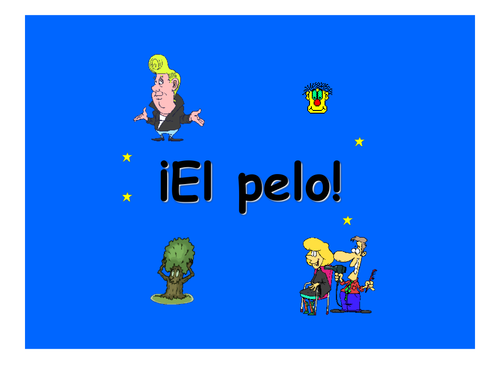

This colourful and fun PowerPoint presentation presents various hair colour and hair styles.
Phrases:
Tengo el pelo rubio.
Tengo el pelo castaño.
Tengo el pelo pelirrojo.
Tengo el pelo largo.
Tengo el pelo corto.
Tengo el pelo ondulado/ rizado.
Tengo el pelo liso.
Llevo barba.
Llevo bigote.
The first slide encourages the students to actively engage with the new vocabulary: working in teams, using their prior knowledge, knowledge of other languages and using a process of elimination to figure out the meanings. They then discuss the pronunciation and question each other before the teacher checks with the whole class. PPC stands for Perfect Pronunciation Challenge!
The following slides allow the teacher to go through each phrase, check the translation, the pronunciation and drill.
Slide 12 can be used for a game of Beat The teacher: The teacher points to a picture and says a word. If it is the correct word the students all repeat it. If it’s the wrong word the students must stay absolutely silent. If they do, they win 1 point. If not, the teacher gets 1 point. Most points wins!
Then there are graded questioning slides followed by What's missing? slides.
Battleships Game
Vocabulary covered:
Tengo el pelo rubio y
Tengo el pelo castaño yTengo el pelo corto y
Tengo el pelo largo y
Tengo el pelo pelirrojo y
Tengo el pelo rizado y
tengo los ojos azules.
tengo los ojos verdes.
tengo los ojos marrones.
llevo gafas.
llevo barba.
llevo bigote.
Instructions
I use this battleships game (which can also be used as a lotto grid) to help students to practise their pronunciation and to reinforce new vocabulary and grammatical structures.
Firstly I ask the students to work independently in pairs to translate the expressions.
I then check the translations and drill pronunciation with the whole class before they play the game. The students secretly choose 5 squares on the top grid and then try to guess which 5 squares their partner has chosen, filling in the bottom grid with “hit” and “miss.” To choose a square say a phrase from the horizontal line and complete the sentence with a phrase from the vertical line. Where the 2 phrases meet up is the square you have chosen.
I use the English language sheet to further challenge the students: they should place this on top of the Spanish version and then try to play the game saying the Spanish phrases as far as possible from memory. I allow the really weak students to have the Spanish version next to the English version so they have lots of support, stronger students are allowed a few “sneaky peaks” at the Spanish version and the really strong students aim to refer back to the Spanish version as little as possible.
Phrases:
Tengo el pelo rubio.
Tengo el pelo castaño.
Tengo el pelo pelirrojo.
Tengo el pelo largo.
Tengo el pelo corto.
Tengo el pelo ondulado/ rizado.
Tengo el pelo liso.
Llevo barba.
Llevo bigote.
The first slide encourages the students to actively engage with the new vocabulary: working in teams, using their prior knowledge, knowledge of other languages and using a process of elimination to figure out the meanings. They then discuss the pronunciation and question each other before the teacher checks with the whole class. PPC stands for Perfect Pronunciation Challenge!
The following slides allow the teacher to go through each phrase, check the translation, the pronunciation and drill.
Slide 12 can be used for a game of Beat The teacher: The teacher points to a picture and says a word. If it is the correct word the students all repeat it. If it’s the wrong word the students must stay absolutely silent. If they do, they win 1 point. If not, the teacher gets 1 point. Most points wins!
Then there are graded questioning slides followed by What's missing? slides.
Battleships Game
Vocabulary covered:
Tengo el pelo rubio y
Tengo el pelo castaño yTengo el pelo corto y
Tengo el pelo largo y
Tengo el pelo pelirrojo y
Tengo el pelo rizado y
tengo los ojos azules.
tengo los ojos verdes.
tengo los ojos marrones.
llevo gafas.
llevo barba.
llevo bigote.
Instructions
I use this battleships game (which can also be used as a lotto grid) to help students to practise their pronunciation and to reinforce new vocabulary and grammatical structures.
Firstly I ask the students to work independently in pairs to translate the expressions.
I then check the translations and drill pronunciation with the whole class before they play the game. The students secretly choose 5 squares on the top grid and then try to guess which 5 squares their partner has chosen, filling in the bottom grid with “hit” and “miss.” To choose a square say a phrase from the horizontal line and complete the sentence with a phrase from the vertical line. Where the 2 phrases meet up is the square you have chosen.
I use the English language sheet to further challenge the students: they should place this on top of the Spanish version and then try to play the game saying the Spanish phrases as far as possible from memory. I allow the really weak students to have the Spanish version next to the English version so they have lots of support, stronger students are allowed a few “sneaky peaks” at the Spanish version and the really strong students aim to refer back to the Spanish version as little as possible.
Something went wrong, please try again later.
This resource hasn't been reviewed yet
To ensure quality for our reviews, only customers who have purchased this resource can review it
Report this resourceto let us know if it violates our terms and conditions.
Our customer service team will review your report and will be in touch.
£2.00
